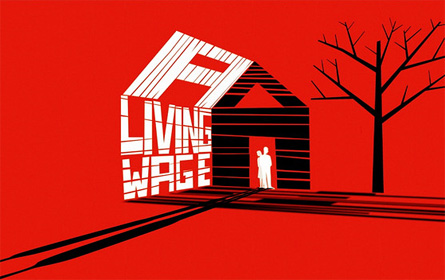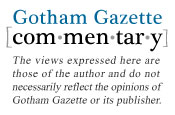
After recently scuttling a bill that would require paid sick days, the Bloomberg administration and the business community now are training their sights on two more City Council proposals intended to help workers. The bills ask developers who receive major taxpayer subsidies to guarantee that the jobs their big projects create will pay decent wages.
In its efforts to combat this initiative, the administration and its allies have raised a number of arguments. But examination of the facts shows that the objections have no basis in reality. Instead, New York's own experiences and those of other cities demonstrate that living-wage policies are important tools for ensuring that development delivers the middle-class jobs that communities -- and our economy -- need in order to recover and thrive.
The City Council Proposals
The City Council proposals would build on the city's current living-wage law, which was enacted in 1995 and broadened in 2002. It guarantees a $10 minimum wage plus benefits or the prevailing industry wage (whichever is higher) for certain types of service workers at companies that operate under contracts with city agencies. The new proposals (Intro 0018 and Intro 0251) would expand these successful local wage standards to workers employed on taxpayer-subsidized economic development projects.
Every year, the city awards many millions of dollars in tax breaks to promote growth across the five boroughs -- everything from the Hudson Yards project on the West Side, to the new Coney Island in Brooklyn. While these projects are touted for the jobs they will create, security guards and cashiers at subsidized projects often are paid just $8 or $9 per hour with no benefits.

Under the City Council proposals, when developers seek such taxpayer subsidies, they would need to recruit tenants and building service contractors that will provide decently paying jobs. Specifically, on projects where developers receive subsidies, all workers would be required to be paid at least $10 per hour -- a very modest wage floor. And for building service workers -- for whom the standard wage in most large buildings in New York is more than $20 per hour -- developers would be required to match that prevailing industry wage.
Big Real Estate, Not Small Businesses
For starters, the administration says the bills would hurt small business. But the developers that receive these subsidies are about as far from small businesses as one can get. And the businesses they bring in as partners are typically major retail and hotel chains, not mom-and-pop shops.
In fact, small businesses generally oppose the city's policy of subsidizing big development projects, because it gives the chain stores an unfair advantage over local mom-and-pops that don't get tax breaks. That is why small-business groups like the Neighborhood Retail Alliance support the City Council's living-wage and prevailing-wage bills. They argue that if these big projects are going to be supported with taxpayer funds, they should at least pay their workers decently.
Developers Will Still Develop
Mayor Michael Bloomberg's other main argument is that it is unrealistic to ask developers to guarantee decent wages and that doing so will kill projects and jobs. That's a serious charge. But the experiences of New York and other major cities present compelling evidence to the contrary.
Although you would never know it from the mayor's rhetoric, Bloomberg has required wage standards on most major development projects across the city in order to win City Council support. This started in 2005 with the redevelopment of the Brooklyn waterfront in Williamsburg and Greenpoint. Bloomberg, then–City Council Speaker Gifford Miller and developers signed an agreement to pay decent wages to the janitors and security guards who would eventually be employed in the buildings there. Far from killing any projects or jobs, the developers eagerly moved forward with new luxury high-rises up and down the waterfront. Today, buildings like the Toll Brothers' Northside Piers complex in Williamsburg operate profitably, while paying their janitors solid, middle-class wages.
Since 2005, the city has gone on to use similar standards on other major projects, such as the Willets Point, Coney Island and Domino Sugar factory redevelopments. There is no evidence that the wage guarantees have hurt the city's ability to recruit developers, or developers' ability to get financing or attract tenants for their projects.
But while New York has begun to make progress, it still must play catch-up to other cities in what it expects from businesses that benefit from taxpayers' largesse. Los Angeles, under Mayor Antonio Villaraigosa, has been the national leader in making the creation of living-wage jobs a top priority. No major subsidized development project there goes forward without a living-wage standard -- not just for building service workers, but employees in all low-wage jobs that may be generated. Projects ranging from the Staples Center/L.A. Live sports-and-entertainment district and the Kodak Theater (host to the Academy Awards), to hotel and retail development projects have been built using living-wage standards.
Los Angeles' economic development agency has found that these standards have not prevented developers from balancing project budgets, getting financing, and finding anchor tenants. The employers that the city has partnered with on these projects include major hotel chains like Marriott, Ritz and the W; food-service contractors like HMS Host and Aramark; and retailers like Trader Joe's and Costco.
San Francisco, under Mayor Gavin Newsom, has used the same strategy with equal success. For example, the massive redevelopment of the city's Hunters Point Shipyard and Candlestick Point section announced this summer (which will include 635,000 square feet of retail, 2.6 million square feet of office and research space, 10,000 residential units, and a football stadium) will require living wages for all jobs in the project area. The Lennar Corp., the nation's second-largest homebuilder, eagerly sought city approval for the project. The city's living wage was so uncontroversial that there was virtually no mention of it during the public debate over the project.
Stalling With a Study
In an effort to delay action on the proposed bills, the Bloomberg administration has commissioned a million-dollar study of the impact that living-wage laws have had across the nation. The administration hired the nation's leading anti-minimum wage economist, David Neumark from the University of California at Irvine, to conduct the analysis. Neumark, who is affiliated with the Employment Policies Institute -- a lobbying group for low-wage employers seeking to keep wages low -- has staked out an extreme and controversial position on wage standards. He opposed even the modest increase in the federal minimum wage to $7.25.
Worse still, his research on living-wage policies has been exposed as fatally flawed. Rather than gather actual data on workers and businesses covered by living-wage policies, Neumark attempts to tease out the impact of such measures from general citywide employment data. However, as more careful economists have pointed out, in most of the cities that have adopted living-wage laws, the policy affects only a very small number of workers. And it simply is not possible to discern the impact -- whether positive or negative -- on such a tiny sliver of the labor market from general data.
Benefits of Living Wages
Last month, the Center for American Progress released an important new national study of living-wage laws that definitively debunked Neumark's findings. It puts to rest the real estate lobby's claims that living-wage policies have impeded job growth by creating an "anti-development" business climate. And it lends support to the large body of careful research over the past decade that has examined actual living-wage policies on the ground -- and documented substantial benefits, not just for workers but also for employers.
For example, in a case study of San Francisco International Airport, University of California economists found the living-wage policy there raised pay by an average of 22 percent for workers such as security screeners, cashiers and restaurant servers. At the same time, airport employers saw annual turnover for security screeners plummet from 94.7 percent to 18.7 percent, resulting in annual savings of $4,275 per employee in recruitment costs. Employers also reported improvements in employee performance, employee morale, and customer service.
Rebuilding the City’s Middle Class and Economy
Bloomberg has begun promoting New York's record of job growth as a model for the nation. But that job growth has produced an hourglass economy, with high-paying finance jobs at the top, low-wage service jobs at the bottom, and less and less for the city's eroding middle class.
Los Angeles has provided a road map for a pro-growth development strategy that expands the tax base and brings in new employers, while improving wages for hotel, retail, and service workers. New York needs to learn from this approach.
Producing more middle-class jobs is vital, not only for New York’s working families, but also for its economy. Because consumer demand powers our economy, a thriving middle class that can afford to spend money at local businesses is essential for sustaining growth. New York's recovery strategy must therefore include initiatives for rebuilding a base of good jobs at good wages for the workers who make the city run. The City Council’s living-wage and prevailing-wage proposals are a good place to start.
Paul K. Sonn is legal co-director of theNational Employment Law Project





